There is an anecdote that, during the rebellion of the Sicilian Vespers in 1282, the inhabitants of Sicily identified the French occupiers who were hiding among the rest of the population by showing them chickpeas and asking them how the legumes were called. Anyone unable to correctly pronounce the Sicilian word ciciri was killed.
700 years later, during The Troubles, calling the Northern Ireland city Derry or Londonderry was (and still is) an indication of your political inclination. Furthermore, the pronunciation of the name of the letter H was/is another informal classifier, with Catholics pronouncing it as “haitch” and Protestants often pronouncing it the English way, “aitch”.
Similar stories of people betrayed by their own pronunciation punctuate history. They are examples of shibboleth. Shibboleth is the Hebrew word for “flood, torrent”. In the Bible, Jephthah uses the word to identify his enemies, the Ephraimites who couldn’t pronounce the initial “sh”. Hence a “shibboleth” became a test-word to distinguish members of an in-group from others.
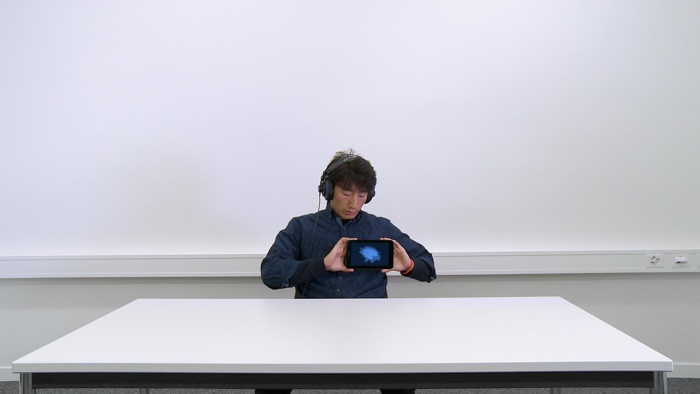
Effi & Amir, By the Throat, 2021
Effi & Amir, By the Throat, (trailer), 2021
As By the Throat, a documentary by Effi & Amir, demonstrates, shibboleth still plays a significant role in contemporary society. Its effects are often life-altering. In the film, an actor has to undergo training so that his regional accent doesn’t pigeonhole him into a regional career. An individual transitioning from one sex to another feels let down by the pitch of their voice. An Iraqi man cannot pass a checkpoint safely until he is able to switch from “El Ezziz” to “Al Aziz” as the wrong sound might identify him as Shiite or a Sunni. Which could expose him to great danger. A Tibetan refugee sees his asylum request rejected because he doesn’t sound Tibetan enough…
The film shows how intimately intertwined phonetics and geopolitics are. Our language, accent, the way we pronounce certain sounds can erect invisible frontiers. Even though they are rooted deep inside our vocal apparatus, these physiological subtleties can expose us to discrimination and violence.
Shibboleth takes on a particularly poignant dimension when it is used as part of asylum request procedures in Europe. The language of the applicants is assessed by linguists and algorithms whose role is to determine whether the accents, vocabulary and expressions used are in line with the origins declared by the refugee. Interestingly, the linguists interviewed by Effi & Amir recognise that both themselves and the machines have to rely on categories and criteria that don’t do justice to the fine nuances of the human experience and the impact these experiences have on language. As a result, a fair number of asylum seekers are prevented from crossing geopolitical borders.
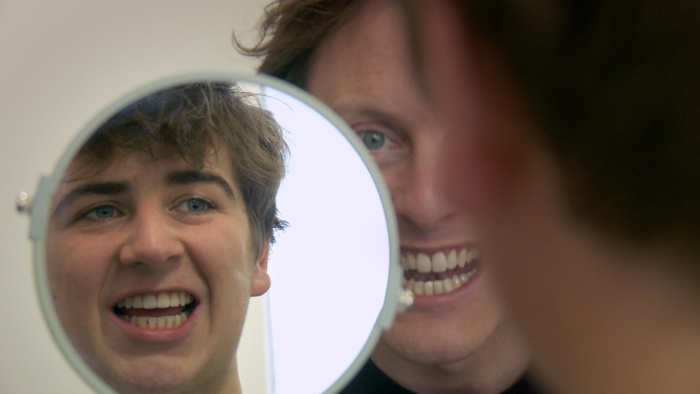
Effi & Amir, By the Throat, 2021
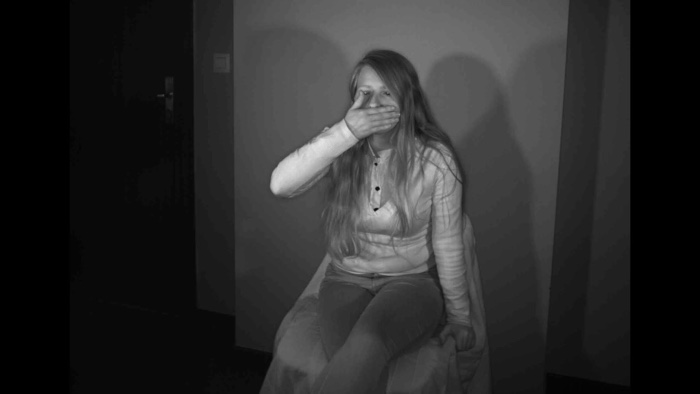
Effi & Amir, By the Throat, 2021
Amir Borenstein et Effi Weiss, aka Effi & Amir, are visual artists whose work involves video, performance and participatory strategies and often deals with the construction of collective and symbolic identities. I interviewed them about their artistic investigation of Shibboleth:
Hi Effi & Amir! By The Throat is inspired in part by a security check procedure at the entrance to the Tel Aviv airport. Can you tell us about this procedure? And how obvious it is to the traveler that the way they pronounce certain words might be assessed?
Who is the object of such scrutiny of vocal sounds (in general, not necessarily in that particular airport) and why?
The security checkpoint at the entrance to the TLV airport is a rather fast checkpoint several kilometers before the terminal that controls vehicle entry to the airport grounds. The procedure is simple, the car needs to stop, a security person waits for a “hello”, usually asks a second question “where are you coming from?” (pointing not to the origin of the traveler but to their geographic point of departure), while scanning rapidly with their gaze the interior of the car and the passengers. A third question would usually follow only if something looks or sounds suspicious. Every car goes through this procedure. We suppose that travelers that are used to being subjected to checks because of their appearance or accent are definitely aware of what is being checked.
The main surprise for me when I saw the film was the breadth of the research. Viewers encounter refugees, people working in call centres, actors, someone transitioning from one gender to another, a speech analyst, a traveler helping a taxi driver to bypass controls, etc. How did you find all these people? How did you know you had to look for them in the first place?
Indeed, this was not a simple thing and it’s one of the reasons why the process was so long. How can one know who has a relevant language-related story? Any person in the street could have been the one we were looking for.
We had two main strategies. One was simply speaking about the project to anyone around us, hoping they would come up with a story or a reference (and they did). The second was more precise, focusing on areas or contexts where we knew there were some “linguistic checkpoints” at play. We learnt about those contexts mainly through a book by the linguist Tim McNamara – Language Testing: The Social Dimension, as well as through our own experiences and encounters. Still, finding people who can actually tell about such situations in the first person was not an easy task and it was a sort of detective work of finding threads and leads, contacting a lot of organisations, hiring local research assistants, and so on.
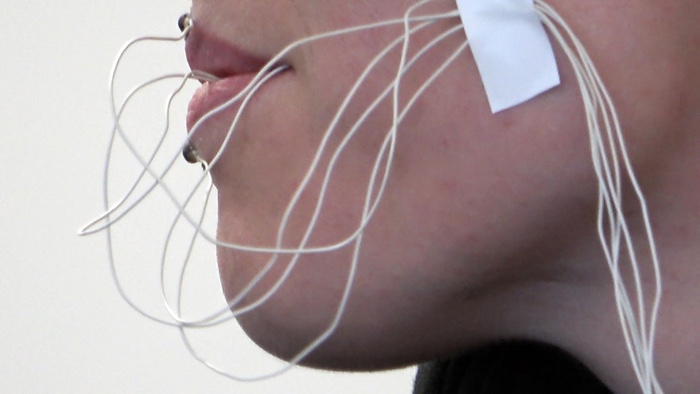
Effi & Amir, By the Throat, 2021
I was also fascinated by the role that technology has played over the years. The film contains numerous archive images showing very curious vintage machines but it also mentions sophisticated computer programs that decision-makers trust but that often fail the human beings under assessment. Did you find, over the course of your research, that technology was helping or hindering humans who have to navigate the ambiguous Shibboleth traps? Can technology be something else than a distraction here?
Most of the technological devices that we show or use in the film were developed for research, therapy and medical purposes. Of course, once a technology is there, it’s not possible to control anymore how it will be used. This applies to any technology. What interested us was not to put technology into trial, but to show how, despite years of technological development and so many different devices and methods, each measuring a different aspect or function of the vocal apparatus, still the human reality, even just the parts of it that are reflected in the voice, defies these definitions, contains grey zones, blurred lines and ambiguities. These zones of freedom, are shrinking rapidly though.
How much is it possible to know about how the analysis of speech is used by immigration authorities in Europe and elsewhere? I would expect such practices to be secret.
This is not a secret per se but the details are not overtly exposed. Like the rest of the asylum procedure, the official steps and guidelines are publicly available while their interpretation and what they mean practically is sometimes more difficult to uncover. Still, lawyers, linguists, NGOs and others who work closely with immigration authorities and asylum seekers have an accumulated experience that can give an insight to those more blurry zones. What definitely stays a secret (or rather, impossible to quantify) is the weight that language analysis has in the asylum decision. Another very important blind spot is the unofficial information that risks to play an important role. We were told by both asylum seekers and researchers that in countries where a language analysis is not part of the procedure, often the interpreter plays this role unofficially and is asked to give an opinion of the applicants’ origin. This might be more harmful than an official test, as there is no record of this unofficial analysis, and therefore it can not be attacked in an appeal.
My mother language is french and no matter how hard i try i never managed to pronounce Guadalajara, the city one of my dear friends comes from. How much can someone cheat? Is it possible to learn how to pronounce sounds that we were not raised to pronounce?
Of course, it is. But probably not all of us can… We are not sure though that the term cheating applies here. Is it cheating to be able to perfectly pronounce a foreign language? In the case of a language test though, the main difficulty is coherency over time.
To make By The Throat, you consulted with Speech and Voice therapists. What have you learned from them regarding the techniques and technologies used to analyse how people sound and what can be inferred from it?
We consulted therapists and others (researchers, linguists, doctors) first and foremost because we wanted to find ways to make voice and its production visible. Therefore we focused on devices that produce some visual output.
What interested us the most was to “see” the invisible border between neighbouring sounds, whether it is defined by the tongue’s position, the shape of the lips or the length of a phoneme. What we realised is that no matter how high the resolution is, there will always be a grey zone, and luckily so.
Places of Articulation: Five Obstructions, Places of Articulation, By The Throat, etc. Several of your works are inspired by Shibboleth. Can you tell us about the current manifestations of this ancient language test? Could you sum up how each of your works articulate and explore Shibboleth differently?
Shibboleth is a linguistic term, designating a word, a phrase or even a phoneme that distinguishes one group from another. The term is taken from a biblical episode where the (Hebrew) word Shibboleth served as such.
All these works are outcomes of the same research and they differ from each other in what they put forward and mainly in the type of spectatorship they propose. The film (By The Throat) is richer in visual materials and develops an argument (a narrative path). The video installation (Five Obstructions) is more fragmented and plays with the idea of territories in a more spatial way and the performance (The 8th Letter) is a participatory event where the body and voice of the audience/participants are put into play.
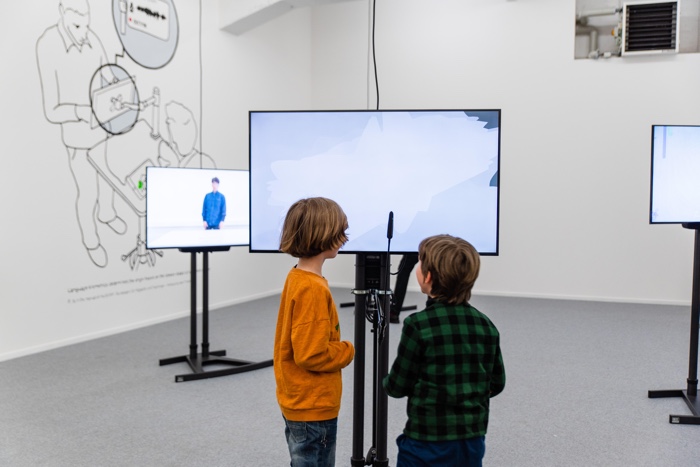
Effi & Amir, Places of Articulation: Five Obstructions, 2020. Installation View, WIELS
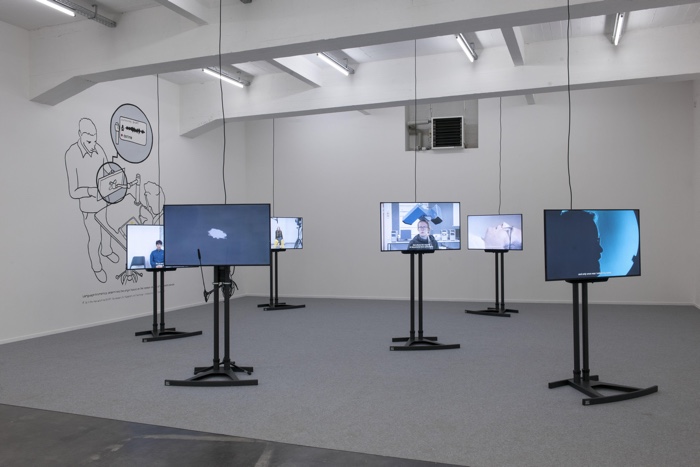
Effi & Amir, Places of Articulation: Five Obstructions, 2020. Installation View, WIELS
Going back to By the Throat, how difficult is it to put in images a topic that is so intimately associated with audio?
This was one of our main challenges as filmmakers. Since the beginning of the process, we were looking for ways of making sound visible and like we mentioned before, we visited a lot of laboratories, clinics and research centers to find these visualisation devices. Still, our aim was not only aesthetic. These visual representations – the output of these devices – could function for us only when juxtaposed with the speakers themselves and especially with the device that produced the representation. On top of the centrality of sound in the work, there was another important element that was difficult to render visible, which is the violence embedded in the “Shibboleth” practice. Filming the speakers recounting their personal, sometimes painful experiences, in a very restricting setting that is dictated by machines was our way to evoke this violence without having to say this word.
Since you work so much with the political and “territorial” dimension of the voice, do you find that it has consequences on your daily life? Do you catch yourself analysing someone’s speech, for example? Or do you try and manipulate your own voice in a specific context? Etc.
As is the case with most of our works, the interest or the questioning exist prior to the work. Something is bothering us, something preoccupies us, puts our perception into question. So, of course, that awareness of this topic comes partially from a personal experience. By the way, it seems to be a very common and shared awareness. Practically every person to whom we told about this work while it was in the making mentioned a personal anecdote in line with the work’s questions. Like one of the speakers in our film says, Shibboleth is ubiquitous, and this is why we found it so relevant.
What changes with the process is maybe the possibility to name things, to put a finger on a specific phenomenon. Otherwise, the effect is rather the opposite of what you describe, because we actually try to avoid analysing other people speech, as we know how problematic it is.
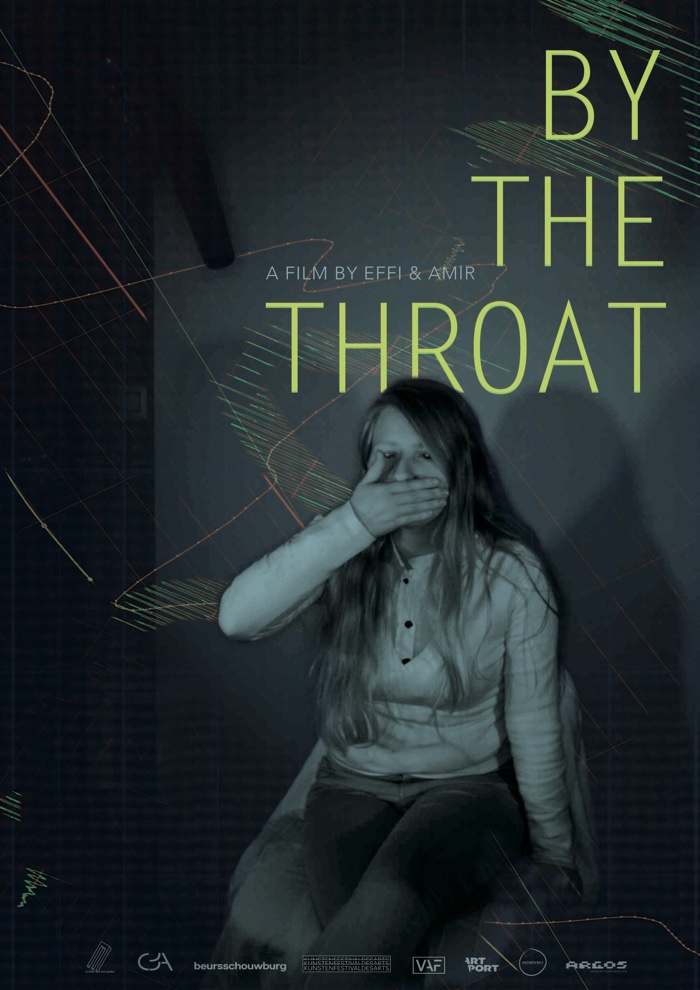
What is next for Effi & Amir? Any upcoming projects, events or areas of research you could share with us?
We finished the film not so long ago and another film a year earlier and we are still busy developing the performance (The 8th Letter) which should be presented in June 2022. We will probably need some time off before we dive into a new process.
Thanks Effi & Amir!
